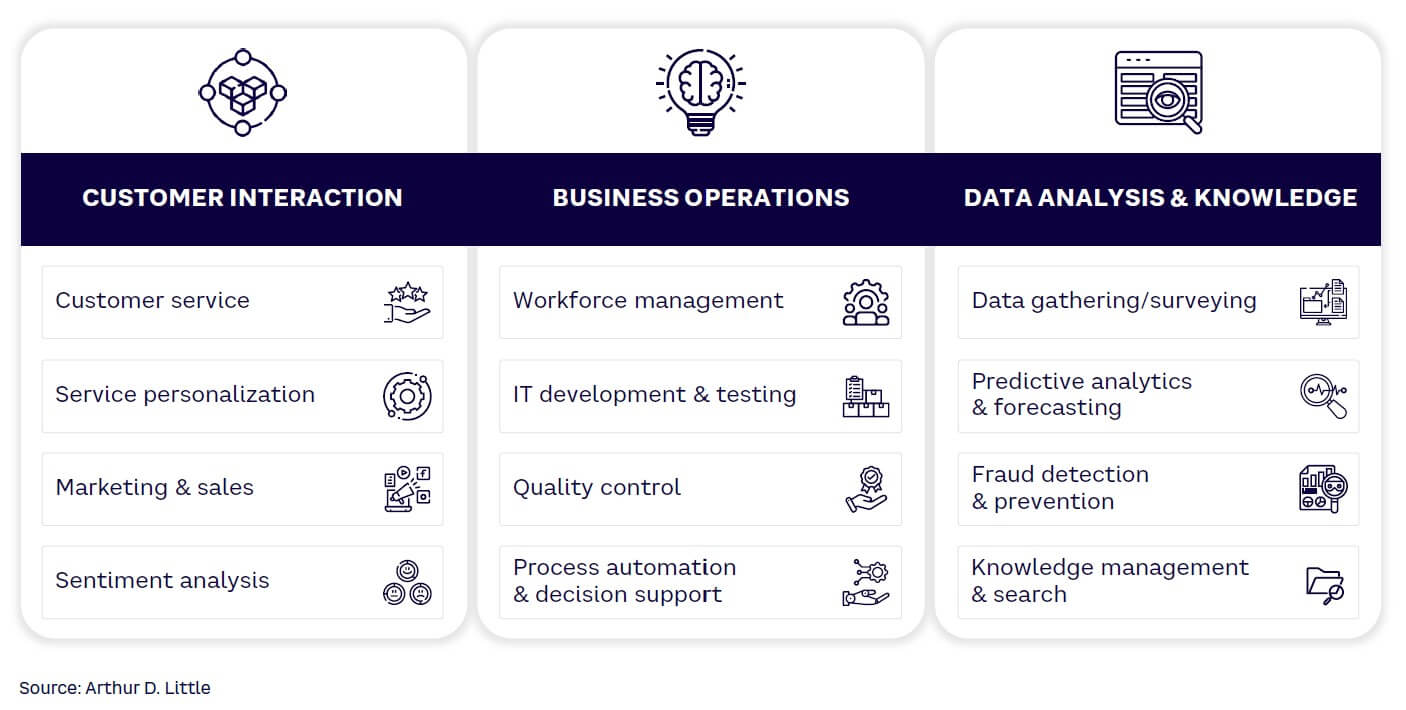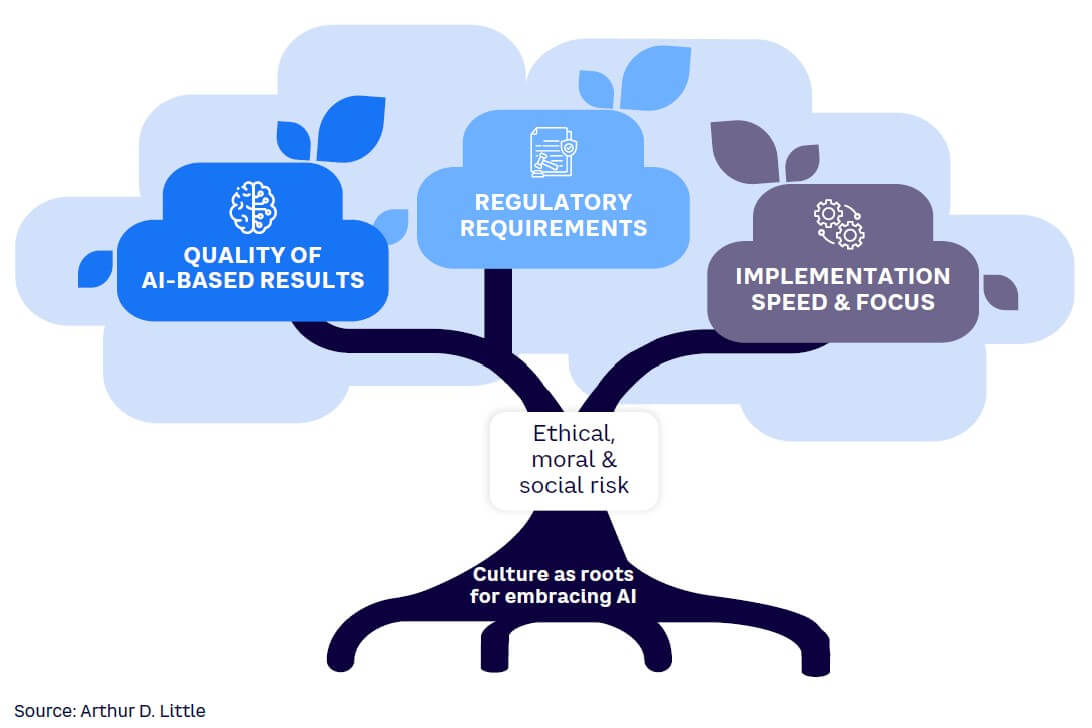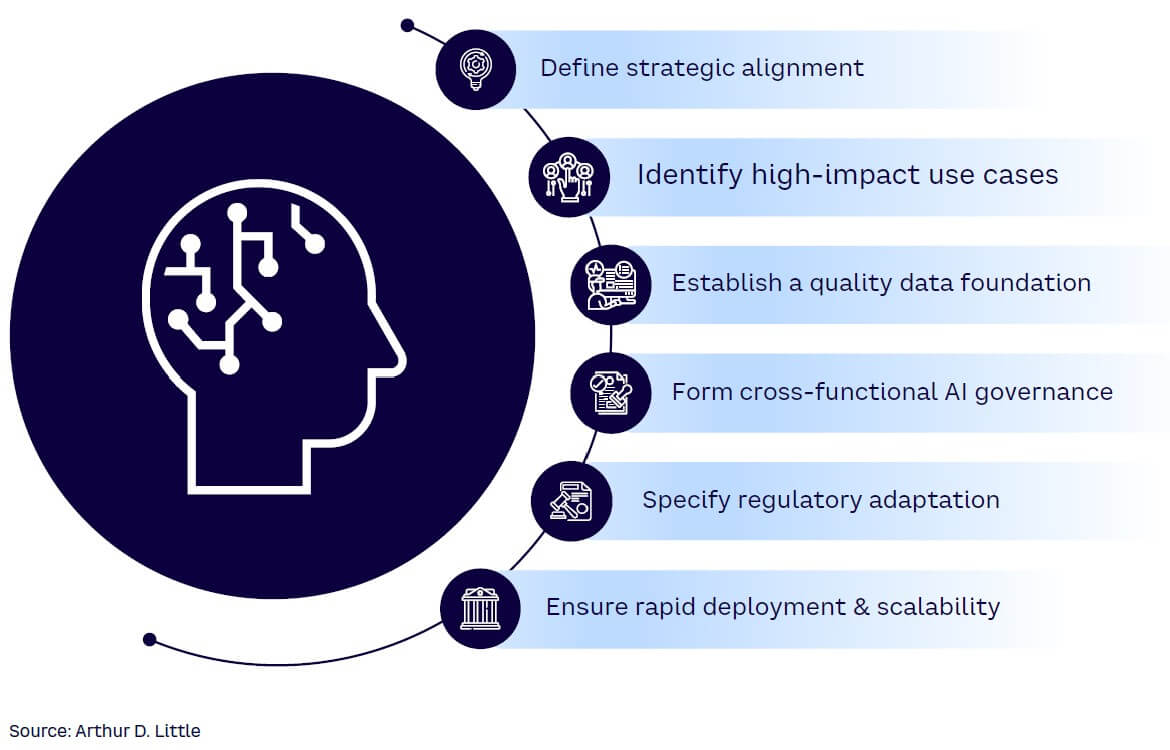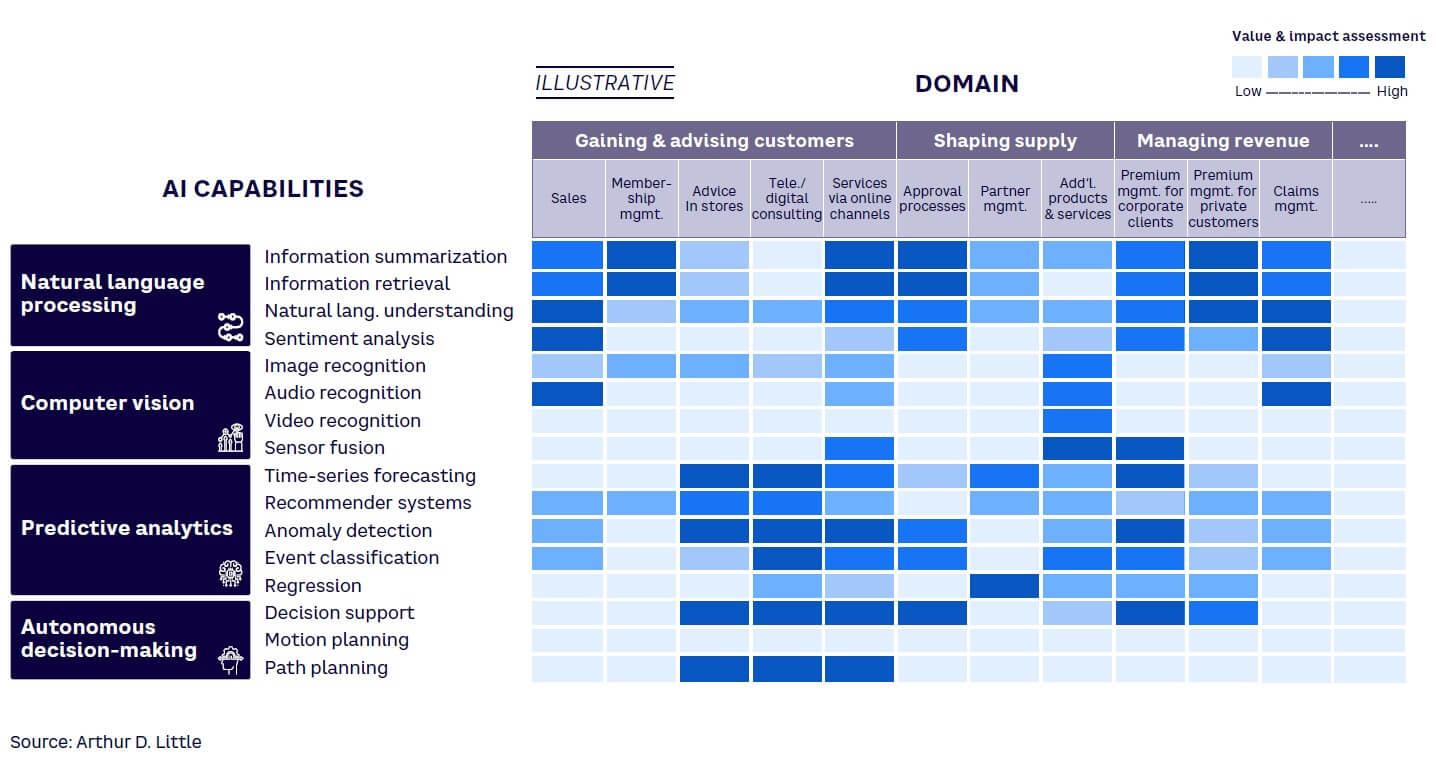
DOWNLOAD
DATE
Contact
Artificial intelligence (AI) can significantly enhance productivity and performance in service industries, as recent use cases demonstrate. To harness its benefits, service companies must ensure that AI is complementing the way their employees work, not disrupting it. Several challenges exist, including ensuring quality results, navigating regulations, and implementing AI at scale. In this Viewpoint, we share steps CxOs can take now to drive innovation and competitiveness through human-AI interaction.
DRIVING PRODUCTIVITY & PERFORMANCE
In today’s dynamic business landscape, service industries grapple with substantial challenges, notably a prevailing labor shortage. As an example, the ifo Institute reported in August 2023 that a striking 75.3% of legal and accounting firms in Germany struggle to secure qualified staff as demographic shifts and other factors intensify the dynamics of the labor market. At the same time, 43.1% of German service companies face a shortage of skilled labor, underscoring the need for streamlined processes to enable specialists to focus on high-value tasks. Similarly, the US Chamber of Commerce reports that in the US, “Even if every unemployed person with experience in the financial activities or professional and business service sectors were employed, only 42% and 44% of the existing job vacancies in these industries would be filled, respectively.”
Rising customer expectations for quick responses, digital interfaces, 24/7 service, and personalized experiences further amplify the pressure. Amid these challenges, AI offers the means to enhance productivity and performance to navigate a fiercely competitive marketplace.
Addressing current challenges
AI has evolved from conventional e-commerce applications to become an essential tool for optimizing processes in service industries. Recent breakthroughs in generative AI (GenAI) and large language models (LLMs) have expanded its applications, allowing automation to extend into creative and more complex tasks — and to take over the sphere of conversations. With these technological advances, a Goldman Sachs report estimates that up to 44%-46% of tasks in administrative and legal professions could be automated in the future. This transformative potential empowers service organizations to tackle industry challenges, providing a competitive edge by propelling productivity and facilitating continuous improvement.
To harness AI’s benefits, companies must ensure that AI is complementing the way their employees work, not disrupting it. But where can service companies get started? This Viewpoint highlights several use cases of early adopters in service industries that have leveraged AI to support daily operations and unlock substantial productivity potential, as well as key challenges and ways to overcome these when embarking on the AI journey.
HOW FIRST MOVERS ADOPT AI
AI is not a distant vision; it’s a present reality for today’s service industries. The critical question is not whether to adopt AI but how to harness its capabilities effectively. Pioneering companies have embraced AI, demonstrating its potential to revolutionize operations, boost productivity, and drive growth through a diverse range of applications.
Example 1: Automated claims processing in insurance
In the insurance industry, where efficiency and accuracy are paramount, AI is reshaping the claims processing landscape. Early adopters have integrated AI and machine learning (ML) to streamline and enhance the speed of claims processing.
An innovative digital insurance company revolves its system around AI-powered chatbots. Using natural language processing, these chatbots accurately extract and categorize key details from policyholders’ descriptions and incident reports, enabling rapid processing of simple claims and ensuring quick payouts.
Benefits
AI-driven systems improve accuracy in data analysis, minimizing errors in claim evaluations. This precision not only enhances the overall claims process but also boosts customer satisfaction. Additionally, the automation reduces manual work, allowing productivity gains and enabling specialists to focus on value-adding instead of transactional activities.
Example 2: Personalized customer engagement in financial services
In the competitive landscapes of insurance and banking, personalization is a key differentiator. AI is enabling early adopters to enhance customer engagement by tailoring insurance plans to meet individual needs. Indeed, some global providers of insurance and financial services are harnessing AI-driven customer engagement to create a personalized experience. Analyzing customer data, including financial behavior, life events, and risk profiles, AI algorithms recommend insurance plans aligned with individual customer needs. For instance, approaching retirement age prompts recommendations for retirement-focused insurance products.
Benefits
As AI-driven personalization can enhance customer satisfaction by meeting individual needs, it fosters long-term relationships and improves customer retention. Moreover, by analyzing customer data, early adopters of AI gain insights for more informed decision-making and targeted marketing strategies.
Example 3: Data-driven investment decisions in finance
In the complex world of finance, data-driven decision-making is critical for success. A leading financial company is leveraging AI to revolutionize investment decisions. It is incorporating AI and ML to transform investment decision-making. Using AI-driven predictive analytics and alternative data sources like satellite imagery and social media sentiment, the company identify emerging trends to make informed decisions reacting to market movements. It also applies AI to algorithmic trading, executing trades at optimal times based on real-time data analysis.
Benefits
AI-driven investment decision-making based on real-time analytics offers substantial benefits, such as increased decision accuracy, improved risk management, and streamlined portfolio adjustments. Furthermore, tailoring investment options to individual clients enhances trust and fosters strong client relationships.
A wide spectrum of possibilities …
These are just a few examples of many opportunities for service companies to utilize AI to yield quantum leaps in productivity (see Figure 1). The horizon of AI applications expands well beyond the use cases highlighted here, with GenAI as a potent tool for accelerating the enhancements of service processes and their back-end operations. Such future-oriented solutions demonstrate AI’s versatility and potential impact.

One such application involves conducting a meta-analysis of customer interactions with sales representatives. AI, through transcribing and analyzing extensive conversation data, identifies recurring patterns in customer buying behavior. This strategic insight aids in optimizing sales techniques and enhancing conversion rates, fostering successful sales interactions.
In another example, a forward-thinking European health insurance company is developing an AI-based knowledge management support system. Tailored for customer service representatives, this system leverages an extensive knowledge base, intelligent search options, and an intuitive interface to provide guidance on complex care situations. The outcome is a tangible improvement in efficiency and employee and customer satisfaction.
Another leading technical services provider harnesses GenAI to revolutionize knowledge management for intricate workflows. By transforming voluminous data and documents into standardized, user-friendly work instructions, including operating procedures and technical illustrations, this approach establishes a comprehensive knowledge base for field technicians. AI-generated guides seamlessly integrate with mobile SAP (Systems Applications and Products) systems, offering a systematic checklist for service tasks. Technicians can leverage the interactive human-to-AI interface for instant access to detailed service guidance, ensuring accuracy, optimizing performance, and adapting smoothly to evolving customer needs.
CHALLENGES TO AI-DRIVEN PRODUCTIVITY
Although the potential is great, many service companies are encountering hurdles in realizing AI benefits. The inherent complexities and limited understanding of AI systems can erode trust, limit a focused implementation, and — in the worst case — introduce new critical business risks. Therefore, companies must understand four key challenges shown in Figure 2 and address them early on to ensure a successful AI scaling to create maximum value:
-
Quality of AI-based results. AI, built on extensive data, constantly improves decision-making and self-learning capabilities. However, the more powerful AI becomes, the less transparent decision mechanisms may be for humans. Establishing a balance between decision transparency and output control is a strategic, procedural, and technical challenge. It requires ensuring high-quality and reliable AI-driven decisions while accepting a certain level of uncertainty to maximize AI’s benefits.
-
Regulatory requirements. In the evolving landscape of AI, legal conditions are in constant flux. Questions regarding ownership and protection of copyrights and patents arise as AI systems become more and more capable of generating creative results. Determining liability for AI system actions can be challenging, as traditional legal frameworks may not adequately address AI decision-making complexities. Regulatory frameworks, such as the EU‘s General Data Protection Regulation (GDPR), add further layers of complexity, impacting AI deployment and data usage.
-
Implementation speed and focus. As with most technological trends, initial ideas and pilots are swiftly implemented, but companies often struggle with scaling AI to reap its full benefits. Fragmented AI activities and a lack of overarching strategic view and governance mechanisms impede progress. Companies, still building up internal resources and skills for AI, grapple with knowledge gaps and organizational uncertainty, hindering widespread AI adaptation. Another limiting factor may be the cultural challenge to adopt a willingness to “fail fast” in the agile implementation of new AI solutions.
-
Ethic, moral, and social risks. As AI systems are integrated into workplaces, ethical concerns related to fairness, transparency, and bias emerge. In service industries, AI systems may need to make ethically charged decisions, such as treatment choices or resource allocations. AI, learning from existing data, may inadvertently perpetuate biases, leading to unfair treatment or discrimination. Aligning AI-based decisions with human values and moral frameworks therefore presents a significant challenge. From a workplace health and safety perspective, increased reliance on AI technologies can furthermore affect mental health and social relationships, potentially isolating individuals.

To overcome these risks and challenges during initial AI implementations, it is essential for companies to proactively define suitable strategies focusing on AI, including human-AI collaboration. In the following section, we outline six steps for CxOs to navigate these challenges and embark on a successful AI journey.
GETTING STARTED WITH AI
As the potential of AI continues to burgeon, CxOs must take decisive steps to seamlessly integrate AI into their organizations. Here are six key actions CxOs should take to begin their journey of AI implementation (see Figure 3):
-
Define strategic alignment. Align AI initiatives with your organization‘s overall strategic goals. Clearly define how AI will support your business objectives to ensure a cohesive strategy that drives growth and innovation. This alignment ensures that AI adoption is not an isolated endeavor but an integral part of the organizational vision and roadmap.
-
Identify high-impact use cases. Conduct a thorough analysis of your organization’s operations to identify areas where AI can add significant value. Prioritize use cases that are routine, data-intensive, and benefit from automation. Focus on the potentials of augmenting human work with AI-driven support, which can increase workforce productivity while retaining key talent. Identifying high-impact use cases ensures a targeted and effective implementation leveraging synergies across business areas and assuring focus in situations where there are scarce resources. The heatmap shown in Figure 4 serves as an example to evaluate potential use cases based on an organization’s strategic priorities.
-
Establish a quality data foundation. Ensure a robust data foundation with a clear, enterprise-wide data management approach to ensure data quality, readiness, and cleanliness. High-quality data is essential for effective AI model training and preventing unreliable AI results. CxOs should invest in data governance practices that enhance the reliability and accuracy of the data used by AI algorithms.
-
Form cross-functional AI governance. Establish a cross-functional AI governance approach encompassing a diverse "core team" with business, IT, and design expertise, as well as integrating across existing company-wide governance processes (e.g., business strategy cycles, project portfolio management, resource planning). This promotes a holistic approach to AI integration and ensures that all aspects of the business are considered. External hiring may be necessary to fill skill gaps and bring in specialized knowledge. Cross-functional governance is crucial for overseeing AI initiatives and aligning them with business goals.
-
Specify regulatory adaptation. Keep up-to-date with the changing legal and regulatory requirements related to AI. Develop a deep understanding of the legal landscape, including data privacy, intellectual property, and liability regulations. Define specific policies in line with company culture, ensuring your organization remains compliant and avoids potential legal issues. CxOs should lead efforts now to establish ethical guidelines and compliance frameworks to guide their workforce during the AI adoption.
-
Emphasize rapid deployment and scalability. Ensure speed and scalability in AI implementation. Develop a clear strategy for rapid testing and scaling to ensure a nimble approach to efficiently deploying AI solutions across the organization. Rapid implementation is critical to achieving fast results and gaining a competitive advantage in the marketplace. CxOs should champion an agile approach with dedicated cross-functional AI teams that allows their organization to pilot and “fail fast” in order to adapt and scale AI solutions based on real-time feedback and evolving needs.
By taking these first steps, CxOs can successfully integrate AI into their organizations to drive productivity, performance, and innovation and thereby stay ahead of the competition.


Conclusion
ACCEPTING THE AI CHALLENGE
In a world where service industries face unprecedented challenges, AI emerges as an opportunity to enhance daily operations and revolutionize customer experience. The goal is not workforce replacement but capability augmentation, enabling growth, innovation, and competitiveness. This Viewpoint explores human-AI collaboration in service industries, highlighting the potential benefits, practical applications, and challenges for AI implementation. Service industry CxOs can harness AI’s power to:
-
Drive productivity and performance. In the face of labor shortages and increased customer expectations, service industries can turn to AI to optimize processes. Breakthroughs in AI, including GenAI and LLMs, offer transformative potential to support service companies with both front-end and back-end activities.
-
Meet high market expectations. Pioneering companies showcase AI’s capabilities in personalizing customer engagement, automating claims processing, and revolutionizing data-driven investment decisions. These examples highlight how AI not only improves efficiency but also enhances accuracy and customer satisfaction.
-
Shape the future of the industry. From analyzing customer interactions to developing AI-based knowledge management systems, service industries should explore AI’s potential for efficiency gains, employee satisfaction, and enhanced service delivery.

